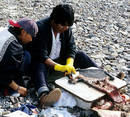Showing Food Bearded seal
| General Information | |||||||||||||
|---|---|---|---|---|---|---|---|---|---|---|---|---|---|
| Name | Bearded seal | ||||||||||||
| Scientific Name | Erignathus barbatus | ||||||||||||
| Description | The bearded seal (Erignathus barbatus), also called the square flipper seal, is a medium-sized pinniped that is found in and near to the Arctic Ocean. Distinguishing features of this earless seal include square fore flippers and thick bristles on its muzzle. Adults are greyish-brown in colour, darker on the back; rarely with a few faint spots on the back or dark spots on the sides. Occasionally the face and neck are reddish-brown. Bearded seal pups are born with a greyish-brown natal fur with scattered patches of white on the back and head. The bearded seal is unique in the subfamily Phocinae in having two pairs of teats, a feature it shares with monk seals. Bearded seals reach about 2.1 m (6.9 ft) to 2.7 m (8.9 ft) in nose-to-tail length and from 200 kg (441 lb) to 430 kg (948 lb) in weight. Both sexes are about the same size. Bearded seals are a primary food source for polar bears and a secondary source for the Inuit of the Arctic coast. The Inuit language name for the seal is ugjuk (plural: ugjuit) or oogrook or oogruk. Although the meat would be eaten and the blubber burnt in the kudlik (stone lamp) the Inuit preferred the ringed seal for food and light. The skin of the bearded seal is tougher than regular seal and was used to make shoes, whips, dog sled harnesses, to cover a wooden frame boat, the Umiak and in constructing summer tents known as tupiq. | ||||||||||||
| Primary ID | FOOD00466 | ||||||||||||
| Picture |  | ||||||||||||
| Classification | |||||||||||||
| Group | Aquatic foods | ||||||||||||
| Sub-Group | Pinnipeds | ||||||||||||
| Taxonomy | |||||||||||||
| Superkingdom | Eukaryota | ||||||||||||
| Kingdom | Metazoa | ||||||||||||
| Phylum | Chordata | ||||||||||||
| Class | Mammalia | ||||||||||||
| Order | Carnivora | ||||||||||||
| Family | Phocidae | ||||||||||||
| Genus | Erignathus | ||||||||||||
| Species | barbatus | ||||||||||||
| Variety | Not Available | ||||||||||||
| External Links | |||||||||||||
| ITIS ID | 180655 | ||||||||||||
| Wikipedia ID | Bearded_seal | ||||||||||||
| Composition | |||||||||||||
| Compounds |
Processing... | ||||||||||||
| Macronutrients |
Showing 0 to 0 of 0 entries | ||||||||||||
| References | |||||||||||||
| Content Reference | — U.S. Department of Agriculture, Agricultural Research Service. 2008. USDA National Nutrient Database for Standard Reference, Release 21. Nutrient Data Laboratory Home Page. | ||||||||||||